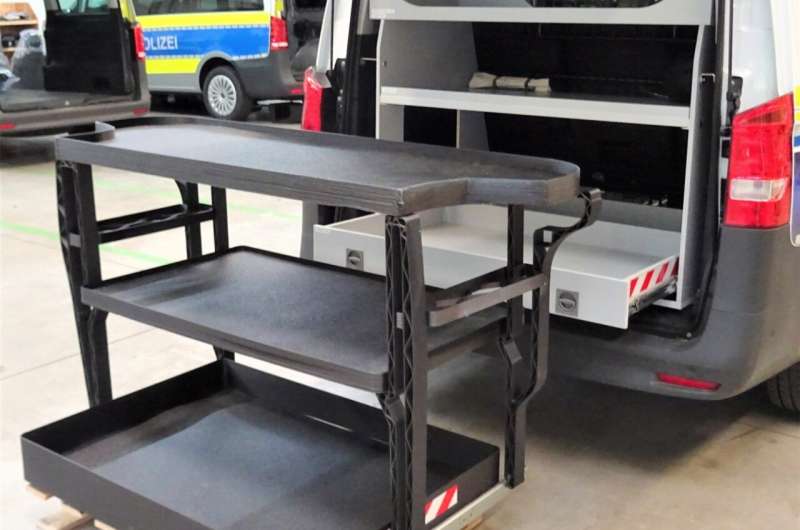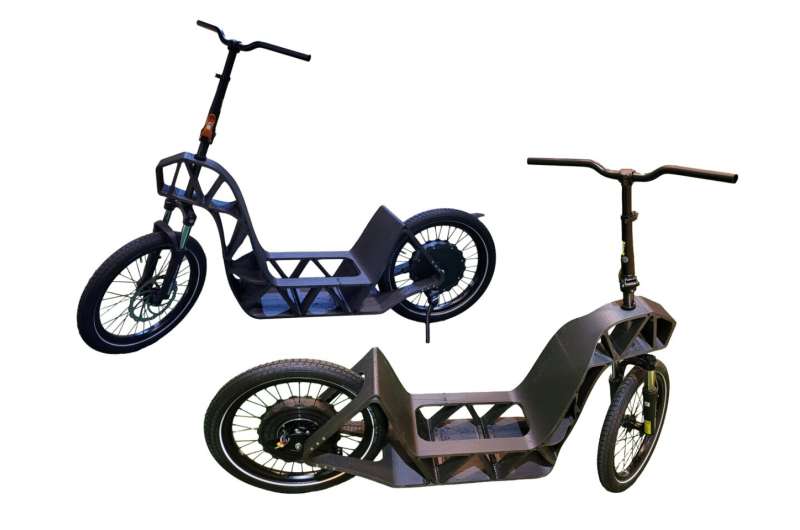This article has been reviewed according to Science X's editorial process and policies. Editors have highlighted the following attributes while ensuring the content's credibility:
fact-checked
proofread
Screw extension additive manufacturing key to load-bearing plastic structures from the 3D printer

With granulate-based plastic processes, it is now possible to design highly durable products and produce them economically, even in closed material cycles.
Fraunhofer IWU demonstrates with a highly resilient shelf and a vehicle frame how individual shaping, low material costs, and high load-bearing capacity can add up to rather useful products. The technology will be demonstrated at the Formnext expo, held November 7—11, 2023, at the Fraunhofer joint booth Hall 11 Stand D31.
3D-printed plastic shelves for battery electric police vehicles: Maximizing carrying capacity
Battery electric vehicles significantly reduce CO2 emissions in the transportation sector. However, the added weight of high-voltage storage systems comes at the expense of allowable payload unless lightweight solutions can be found elsewhere. Fraunhofer IWU and MOSOLF Special Vehicles GmbH suggest a smart solution for simultaneously reducing weight while optimizing cargo space: a 3D-printed rear shelf. Using the Mercedes Vito as an example, the shelf and its fittings can save 26.5 kilograms compared to the previous retrofit solution.
The payload capacity of the shelf system remains fully unchanged. The lower drawer in the new shelf can bear up to 100 kilograms. The system's durability and flexibility are crucial requirements as the equipment for police use becomes increasingly heavy. Ballistic shields, for example, add considerable weight. Nevertheless, the new shelf must provide flexible transportation for traffic control, patrol duties, or police personnel transport at large-scale operations.
The newly developed shelf seamlessly fits the vehicle's exterior, requiring no additional reinforcements or attachments, thus optimizing the cargo space in the rear. The new upper compartments offer even more storage space, thanks to an 8% enlarged storage area. Naturally, the shelf is as safe as the standard retrofit version.

DynaLight: 3D-printed plastic frame for cargo scooters
Electrically powered cargo scooters will play a crucial role in emissions-free short-distance transportation in the future. Saving vehicle weight means more payload capacity. However, safety should not suffer at the hands of weight optimization. The designers of the Innvelo Cargo-Scooter from the Chemnitz research institution ICM first banked on a steel frame. The partners in the DynaLight project now suggest a robust plastic solution—printed with screw extension additive manufacturing (SEAM) technology like the rear shelf for the battery-electric van. The new plastic frame saves approximately 10% in weight and costs.
Naturally, it is just as practical as the old one: delivery services can transport a crate of beverages or a thermobox on the carrier, with a total payload capacity of about 200 kilograms, including the rider. Partners in the DynaLight project include Fraunhofer IWU, the Chemnitz Institute for Machine and Plant Construction e.V. (ICM), and Sauer Creations.
SEAM cycle: Fast, granule-based, recyclable 3D printing
SEAM technology was used for manufacturing the shelf and the frame. This 3D printing process opens up new product and manufacturing possibilities on an industrial scale—it allows for large production quantities at competitive costs in a short time. The SEAM process developed at Fraunhofer IWU is not only eight times faster than conventional 3D printing. It relies on processing cost-effective standard plastic granules. This way, compared to classic Fused Layer Modeling (FLM) processes that use an expensive filament, production costs are up to 200 times lower.
SEAM also contributes to the circular economy approach, as it can use granules obtained from recycled thermoplastics without devaluing the plastic from the previous product. Plastic bottles can also become highly resilient shelves or load-bearing frames for E-scooters in a second life.


















